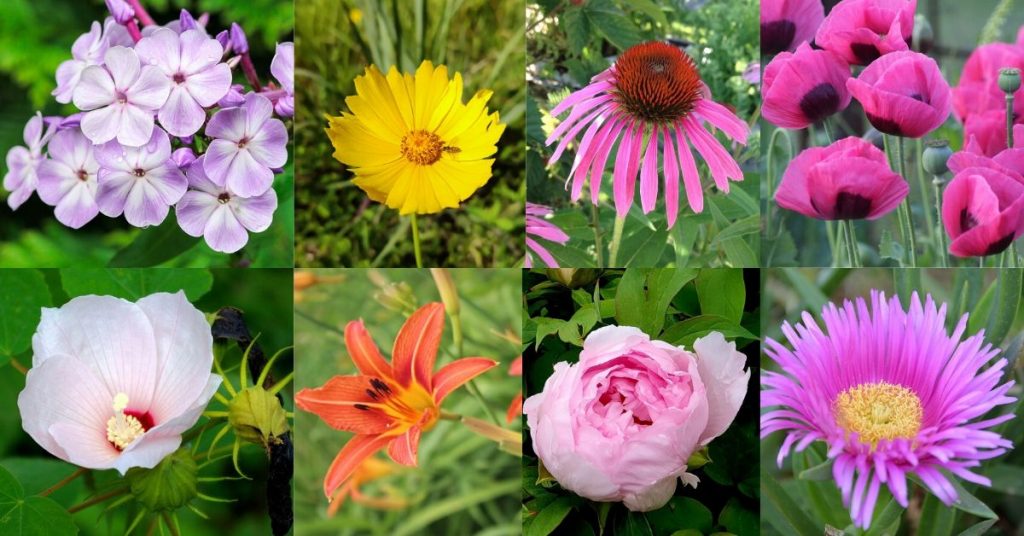Gardening may look a lot easier than done since flowering plants give colorful and fascinating blooms that effortlessly beautify the environment. However, unknown to most, it could get more complicated than that. But there are ways to make gardening a lot easier.
- What Are Perennials?
- The Top Flowering Perennials You Can Grow for Your Garden
- Black-Eyed Susan
- Purple Coneflowers
- Daffodils
- Hydrangeas
- Peonies
- Daylilies
- Bee Balm
- Delphinium
- Iris
- Hardy Hibiscus
- Ice Plant
- Sedum
- Coral Bells
- Yarrow
- Salvia
- Cranesbill
- Mums
- Asters
- Blanket Flower
- Tickseed
- Sea Holly
- Forget-Me-Not
- Bleeding Heart
- Garden Phlox
- Bellflowers
- Canna Lily
- Red Hot Poker
- Hollyhock
- Lavender
- Russian Sage
- Shasta Daisies
- Speedwell
- Catmint
- Penstemon
- Pincushion Flower
- Lamb’s Ear
- Balloon Flower
- Poppies
- Roses
- Dianthus
Despite countless gardening tips and techniques out there, the key to successful plant care is having adequate knowledge about plants. There are three general types of plants based on life cycle – annuals, biennials, or perennials. And if you are looking for low maintenance plants that grow back season after season to add in your garden, then perennials are your best bet.
We curated below the most popular flowering perennials in the world to help you understand perennials better. Some of them require extra care than usual, but most are low maintenance and can be the foundation of your garden.
What Are Perennials?
Perennials are plants that need two or more few years to complete their life cycle. They reproduce either by seeds or vegetative forms of reproduction. Unlike annuals, perennials grow back year after year, so you only have to plant them once (1).
These plants typically flower for only a single season each year – either spring, summer, or fall. Some go dormant during the winter and regrows the following spring while others keep their foliage throughout. Because perennials put more of their energy into growing roots than growing flowers, they produce fewer flowers than annuals.
The Top Flowering Perennials You Can Grow for Your Garden
Black-Eyed Susan

The Black-Eyed Susan (Rudbeckia hirta), which is also called Bristly Coneflower, Brown-Eyed Susan, and Gloriosa Daisy, is one of the most famed ornamental plants. It can be an annual, biennial, or short-lived perennial depending on the variety (2).
A native from much of the United States (3), this sun-loving ornamental from the Asteraceae family grows up to 1 to 3 ft high. It has a taproot and upright and stiff stems covered with short and soft hairs.
Each stem produces a lone bright yellow-gold flower, which consists of single petals and dark and cone-shaped center, that blooms from summer to early fall.
Black-Eyed Susans are well-liked as cut flowers primarily because of their bright colors. Most varieties thrive well in full sunlight.
These flowering perennials are relatively harmless, though there are reports that ingesting the above ground parts of the plant can be mildly toxic to animals like cattle, swine, horses, and cats.
Purple Coneflowers
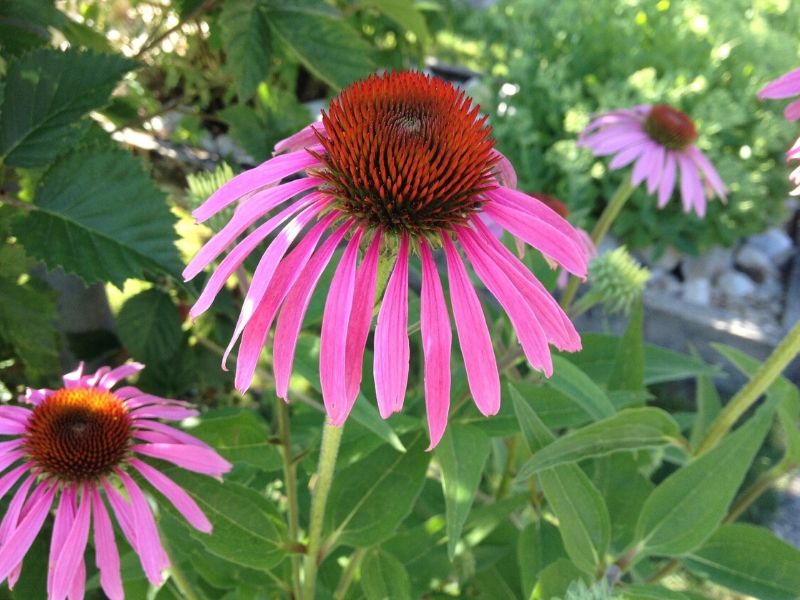
Also from the Sunflower family is this purple ornamental called Purple Coneflowers or Coneflowers. Also known as Echinacea purpurea, this herbaceous perennial flowering plant flaunts a distinctive cone-shaped flowering head at the center with purple, tongue-shaped florets that tend to grow away from the center.
Because of their attractive colors and long, sturdy stem, Purple Coneflowers are top favorite cut flowers for bouquets. They are also popular in medicine as a natural remedy against the flu and common colds (4).
Purple Coneflower (Echinacea spp.) is known to be non-toxic to animals and humans. However, pets like dogs tend to ingest a large amount of these plants, which often results in discomfort.
Daffodils

Known for their trumpet-like flowers, Daffodils (Narcissus pseudonarcissus) come in several attractive colors such as yellow, white, pink, and orange, and type (5).
These plants bloom in late winter or early spring, with flowers lasting one to three weeks. Growing daffodils require moist but well-drained soil. These flowering perennials, which are native to northern Europe, shoot up from an underground bulb or a modified stem and can reach up to 41 cm (16 inches) tall.
Although undeniably attractive, Daffodils are one of the most common poisonous plants. All plant parts contain lycorine, a toxic chemical that may cause nausea, diarrhea, abdominal pain, vomiting, and convulsions.
Daffodil bulbs, which often mistaken as onion bulbs, have the highest concentration of lycorine hence the most toxic part of the plant. Aside from lycorine, the bulbs also carry oxalates, which cause skin irritation and severe burning.
Hydrangeas
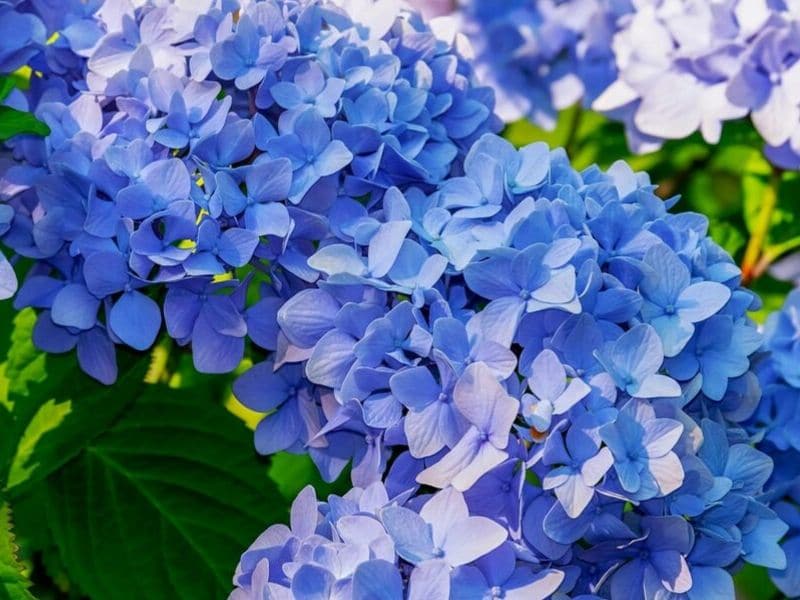
One of the best perennials, hydrangeas come in different color varieties that can effortlessly make any garden stand out. These perennial flowers produce attractive flowers throughout the summer season if taken care of appropriately.
Typically, hydrangeas bloom in shades of blue, purple, and pink, but other varieties display green, white, or red flowers.
Interestingly, the colors of hydrangea flowers (for some varieties) changes as they mature, while others vary depending on the soil composition and pH levels.
Generally, hydrangeas are not toxic unless ingested in massive amounts. The plants, particularly the flowers, buds, and leaves, contain a chemical compound known as glycoside amygdalin.
Although this chemical compound itself is not toxic to humans and animals, it can break down to produce cyanide once metabolized. Symptoms of Hydrangea poisoning by ingestion often include vomiting, diarrhea, or depression.
Peonies

Common Peonies or Paeonia officinalis are long-lived perennials that require minimal care and maintenance once fully established.
This famed ornamental can be herbaceous, tree type, or intersectional. Peonies, in general, typically commence flowering in late spring.
Herbaceous type peonies produce flowers from May to June that last for 7 to 10 days, while tree type peonies bloom for more or less 14 days. Intersectional peonies, which are a hybrid between the two types, produce more flowers that last longer, usually 3 to 4 weeks (6).
Peonies are not dubbed as the “King of Flowers” for nothing. Not only are they alluring, but they are fragrant as well and holds a rich history and fascinating symbolism.
These spring blooms can be harmful both to humans and pets. The roots, flowers, and seeds contain paeonol, which, when ingested, may cause diarrhea, skin irritation, nausea, raised heartbeat, and shiverings.
Daylilies
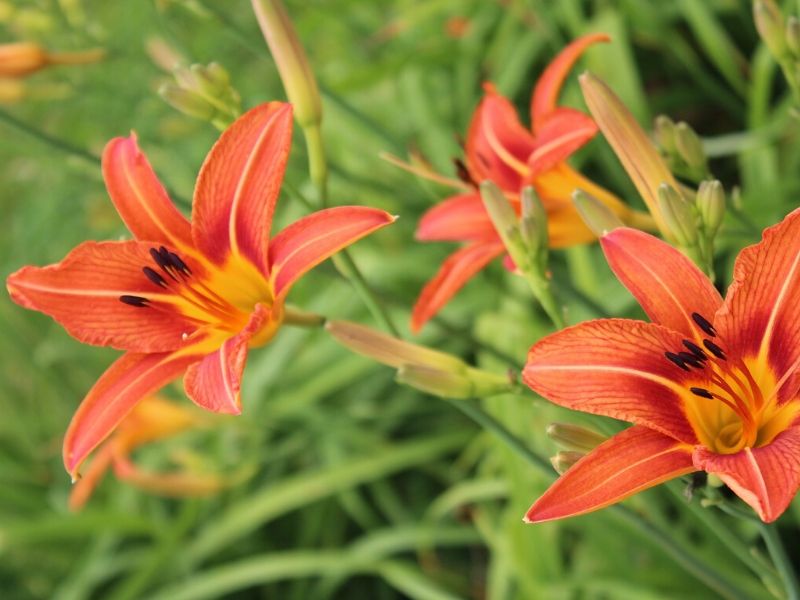
Whether you’re a beginner in gardening or just looking for an easy-to-grow plant, daylilies or Hemerocallis could be one of your best options.
They aren’t true lilies, however. While true lilies belong in the Liliaceae or lily family, daylilies are from the Hemerocallidaceae subfamily in the Asphodelaceae family (7).
This perennial plant offers alluring flowers that last for no more than 24 hours. Some daylily varieties bloom time on and off throughout the summer months while others put on a great, dramatic show once a year.
Daylilies (Hemerocallis spp) endure light shade, but they thrive best in full sun. Reproduced from thick, tuberous roots, each daylily plant can reach around 1 to 4 ft in height upon full maturity.
This hybridizers-favorite ornamental has varying flower types depending on the variety. Some daylily flowers are circular, while others can be triangular, star-shaped, spider-shaped, or double ruffled.
Daylilies, like true lilies, are dangerous for animals but not as extremely toxic to cats. All plant parts are toxic, including the stem, flower, leaves, and pollen. Ingesting even a small amount of this flowering plant often make cats develop fatal kidney failure (8).
Bee Balm

Bee balm (Monarda spp.), also recognized as wild bergamot or Monarda, is a perennial plant native to North America. These herbaceous perennials, which attract hummingbirds, butterflies, and bees as well as flower aficionados, produce brilliant pink, red, white, or purple blooms and aromatic foliage. (9).
Bee balm prefers full sun and fertile, moist soil, but can tolerate shade. Each plant grows up to 2.5 ft (76.2 cm) to 4 ft (122 cm) in height. Bee balms, albeit renowned for their beauty, are also cultivated as food, flavoring, and medicinal crop.
Unlike the first few flowering perennials in this list, Bee Balms are non-toxic. They are one of the best options to add in your garden if you have small children or pets since these plants are harmless.
Delphinium

They say that blue is one of the rarest colors that one can find in flowers. And for that reason, Delphiniums have secured a spot in the world of ornamentals.
Commonly grown as an attractive vertical addition to flower beds, Delphiniums present tall, spiky blooms that often come in shades of blue.
Are blue flowers not your cup of tea? Fret not because other Delphinium hybrids offer more color choices, including pink, yellow, white, lavender, and red. Giving the perfect contrast to these brightly colored blooms are equally attractive dark green, palm-shaped leaves.
Note that Delphiniums require extra care than other perennial flowers. Classified as short-lived perennials, they thrive best in mild weather and not under hot weather conditions. Plant them in a sunny area with consistently moist soil that has proper drainage to maximize their beauty.
Delphiniums are lovely but poisonous. The plant contains toxic chemicals that may harm humans and animals when ingested or touched. Younger plants have higher concentrations of these chemicals, hence more poisonous. Direct contact with Delphinium flowers and leaves may cause skin irritation, while consumption may result in respiratory paralysis.
Iris

The Iris plant, considering its wide color variations of enthralling blooms, only proves why its name translates to the Greek goddess of the rainbow.
The Iris genus has over 200 species and countless cultivars, so one can readily find them in blue, pink, purple, orange, yellow, brown, black, and white blossoms (10).
Each Iris flower has six petals that are of two different types: standards and falls. Standards are the inner and upright petals, while falls are the outer petals that curve downwards.
Generally, Irises have three types based on flower characteristics: bearded, beardless, and crested. Bearded Irises, which is one of the most prevalent perennials in the world, have distinct “beards” or soft hairs along the central portion of the falls.
The beardless type, which lacks this unique feature, has smooth petals. Crested Irises, on the other hand, have a ridge or cockscomb (raised tissues) instead of beards. Among the three types, crested irises are the least popular (11).
The bulbs, leaves, and stems of Iris plants are poisonous as they contain toxic compounds like irisin. Ingesting the plant may cause abdominal pain, nausea, vomiting, diarrhea, fever, and skin irritation.
Hardy Hibiscus
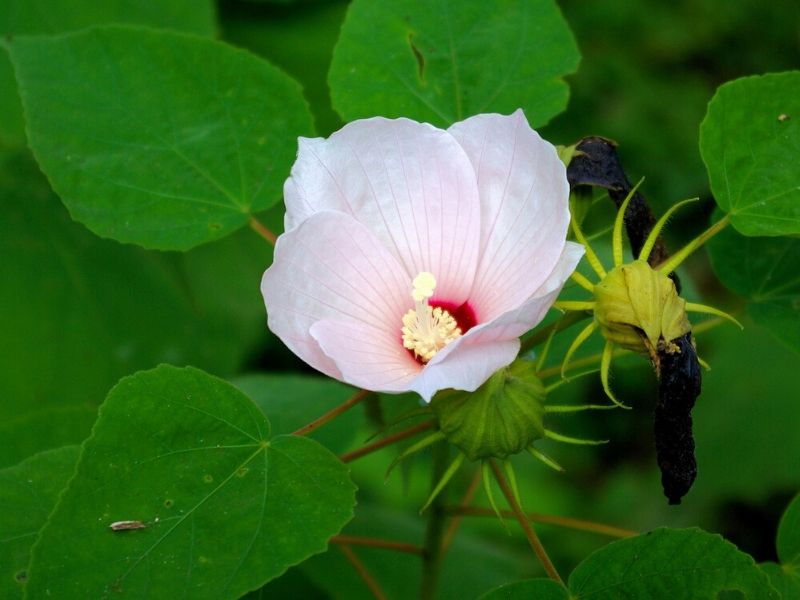
Another gorgeous perennial to add in your garden is the Hardy Hibiscus or also called Swamp Rose Mallow. It flaunts prominent, bell-shaped flowers in single-form colors, including red, white, and pink, that are often as large as dinner plates.
This slow-growing perennial typically reaches 2 to 5 ft in height upon full maturity. While its tropical counterpart, the Tropical Hibiscus, cannot tolerate the winter, the Hardy Hibiscus can thrive well in such conditions as long as you provide them full sunlight and well-drained soil. Hardy Hibiscus plants are considered non-toxic to humans and animals.
Ice Plant
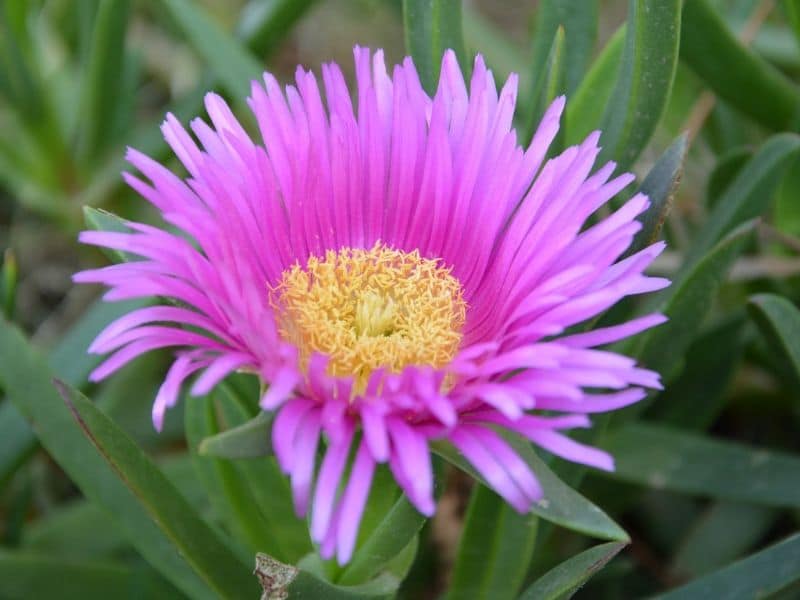
Delosperma or more commonly identified as Ice Plant or Hardy Ice Plant is another easy-to-grow perennial that could add a splash of bright hues in your backyard.
Ideal as a groundcover, ice plants grow only up to 3 to 8 inches in height and up to 4 ft in width. They exude mostly evergreen foliage with colorful daisy-like blooms that last nearly throughout summer and fall.
Some of the most well-known varieties of Ice Plants include Delosperma herbeau (white), Delosperma cooperi (purple), Delosperma brunnthaleri (yellow), and Delosperma floribundum (pink with a white center).
Ice Plants are succulents, which means that they thrive well even in drought-like conditions but not in wet soil. They also tolerate some light shade, but you can maximize their beauty if you place them in a sunny spot.
Almost all varieties of Ice Plants are non-toxic and safe for planting around small children, dogs, and cats.
Sedum
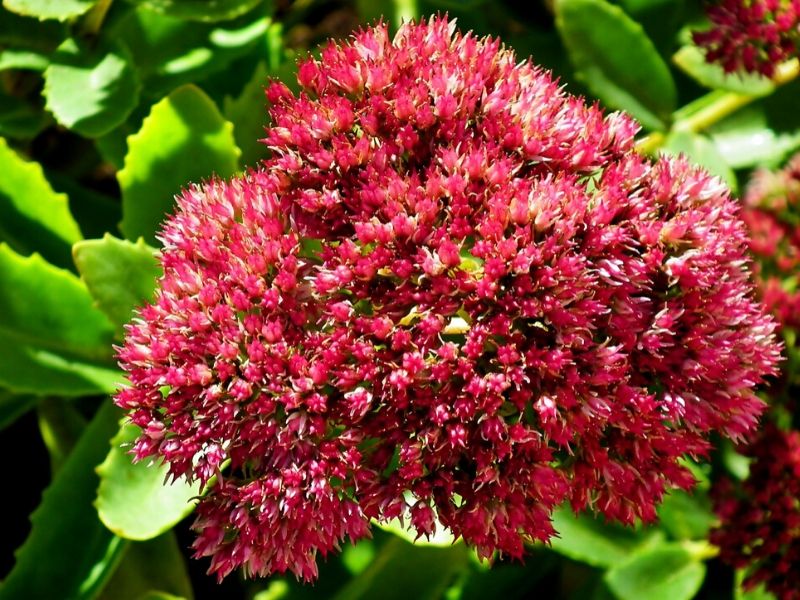
Another popular groundcover in this list is Sedum or Stonecrop. Distinguished for being low maintenance and drought-resistant, Sedums are succulents requiring only full sun and well-draining soil (12).
Sedums have two main types: low growing and upright. Low growing Sedums are the ones you need if you are looking for the easy-to-maintain border plant or ground cover. They spread along the ground and reach only a few inches in height.
Upright or tall Sedums, on the other hand, displays tall clumps with clusters of small, vivid flowers that blossom from mid-summer to early fall.
Some succulents are known as toxic to both humans and pets, but these long lasting flowers, in general, are one of the exceptions.
Coral Bells
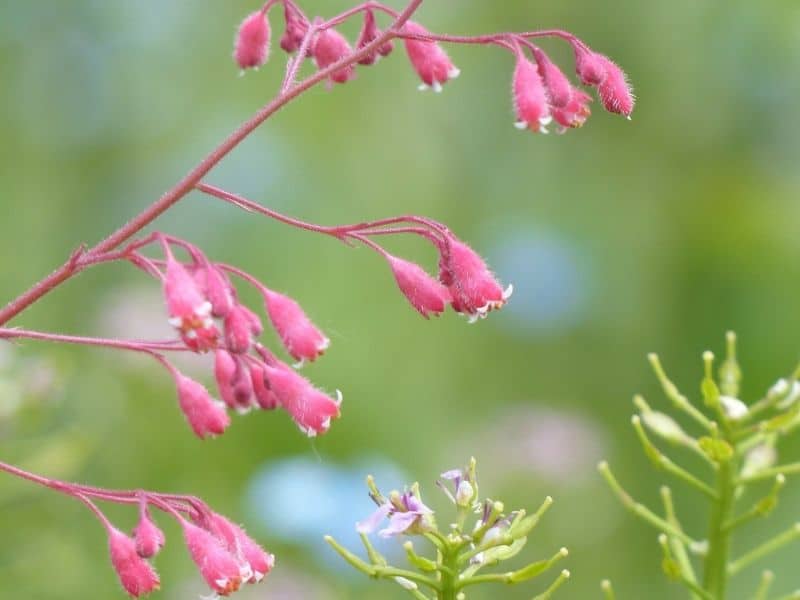
Heucheras or Coral Bells are shade loving plants with equally attractive foliage as their blooms. Best known for their color-infused leaves like bronze, golden yellow, red/brown, and black, to name a few, Coral Bells produce spikes of vertical, tall, and bell-shaped flowers that typically bloom in late spring to early summer (13).
The flowers of Coral Bells also vary in color, which ranges from white to light coral and deep red.
Coral Bells grow best in full sun to part shade. They also tolerate full shade as long as the soil is kept moist.
Yarrow
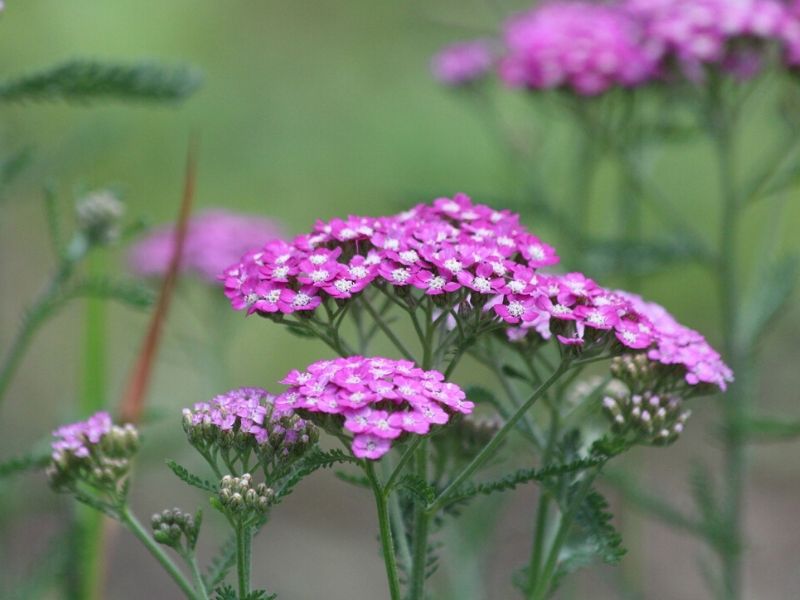
Yarrows or Achillea millefolium is a fast-growing ornamental from the Asteraceae family. Because of this quality, Yarrows are an ideal choice if you are in a rush to fill your landscape with a burst of attractive and colorful blooms.
Yarrow is a tough perennial that can resist heat, drought, and cold throughout much of the United States.
This perennial has small flowers that form in clusters and come in many different colors, such as pink, yellow, red, orange, purple, peach, and white. Flowering occurs mostly during mid-summer. Yarrows grow up to 3 feet tall upon full maturity.
Although mainly cultivated as ornamentals, Yarrow plants are also popular as herbal remedies against wounds, infections, colds, and flu (14).
Despite the medicinal properties of Yarrows, these ubiquitous herbs can be toxic to animals like dogs, cats, and horses. They produce pyrrolizidine alkaloids as a defense mechanism against herbivores, which may induce vomiting, diarrhea, urination, and dermatitis (15).
Salvia
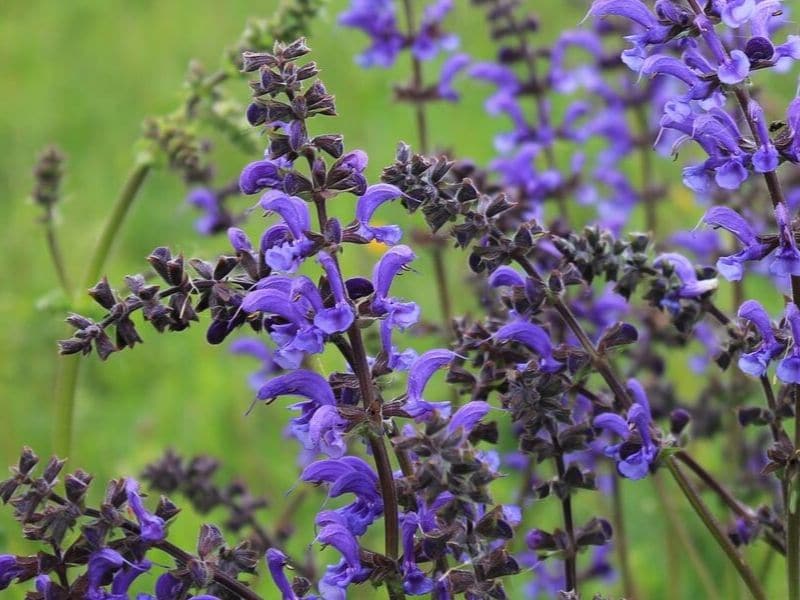
Perennial Salvia or Common Sage is one option to look at if you are looking to add bright colors in your landscape.
Colorful tall spikes of blossoms attract bees, hummingbirds, and butterflies that come in a wide range of hues, including lavender, blue, white, dark purple, rare yellow, and red. Flowering often occurs from late spring to fall.
Salvias grow well in hot weather conditions. These ornamentals from the mint family are drought-resistant, deer resistant and easy to maintain and cultivate.
Most Salvias are generally safe or non-toxic to both humans and animals. Hence, planting these perennials in your garden would save your pets from sudden vomiting, nausea, or any discomfort and toxic effect from poisonous plants.
Cranesbill
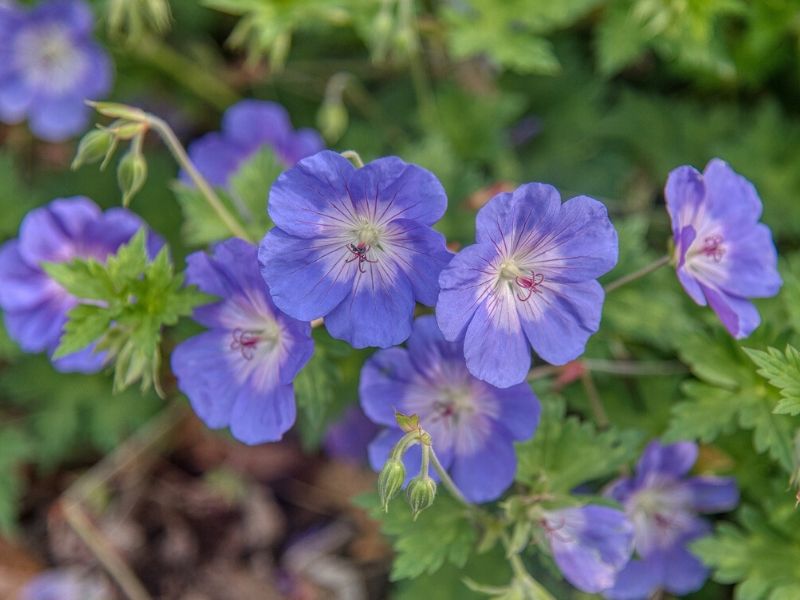
Geranium sanguineum, commonly known as Cranesbill, Geranium, or Alpenglow, is a hardy perennial native to temperate regions. It grows about 12 inches to 18 inches in height, which makes it an excellent groundcover. It is named as cranesbill because its long and slender fruit resembles the bill of a crane.
Cranesbills flourish best either in full sun or partial shade with well-drained soil. They can withstand heat and drought conditions and a few insect or disease problems.
Many species and cultivars are available for cranesbills. Depending on the species or cultivars, most flowers, which have five small petals, bloom in late spring to early summer for 2 to 4 weeks. Color variations include pale pink, white, lavender, purple-pink, and blue, among others.
Cranesbills have a variety of uses and considered non-toxic to humans and pets. They are popularly used for cakes, teas, astringents, and compresses. Cranesbill oils, on the other hand, are used in creams, lotions, insect repellents, and lice shampoos. While Cranesbills are harmless, the other common Geranium (Pelargonium spp.) is noxious to dogs, cats, and horses.
Mums

Chrysanthemums, or generally referred to as Mums, are one of the most famed and vital ornamentals. First cultivated in the Eurasia region, it is now extensively cultivated across the globe with countless species and cultivars in different shades of blooms.
Growing Mums generally require either full sun or partial shade with well-drained soil. Each plant usually reaches up to 3 ft tall, with captivating blossoms in white, pink, red, orange, yellow, and purple.
Because of different varieties available, Mums have different blooming periods. While most commence flowering during the mid-summer period, other types bloom in early fall or late fall.
Note, though, that Mums can be harmful to humans and especially to cats, dogs, and other animals. The leaves and stalks, in particular, are the poisonous parts. If ingested by pets, Mums may cause gastrointestinal discomfort or skin inflammation. Long periods of exposure to these plants may likewise result in contact dermatitis in humans.
Asters

While most perennials in this list flower during the summer season, asters are a standout because they help to add bright colors to your flower gardens even during the fall.
Asters are fall-blooming hardy perennials that offer a broad range of colors in various heights. Depending on the variety, blooms present red, pink, white, purple, or blue colors. The flowers are small with star-shaped flower heads.
Asters, in general, flourish better with moist, well-drained soil and full sun. Most of them reach up to 4 ft tall, but others can be compact like the Alpine variety. Deadheading can help produce more blooms (16).
Blanket Flower
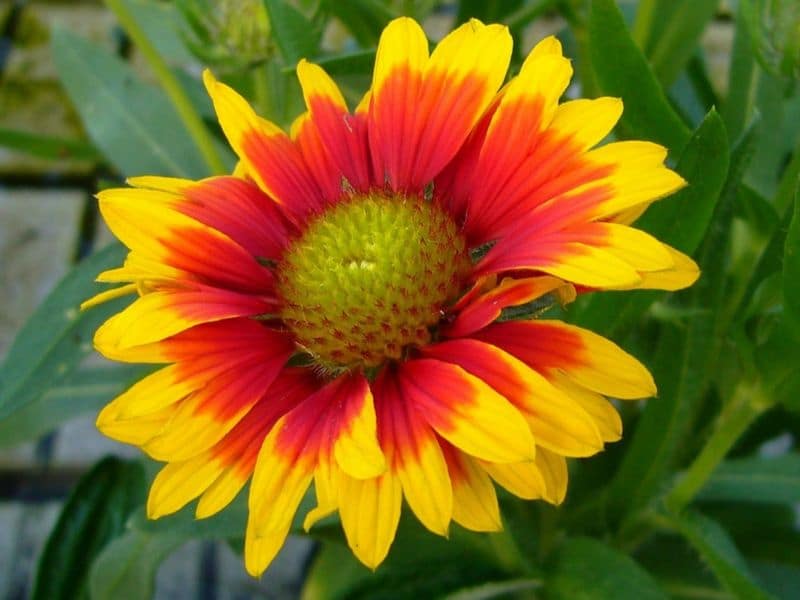
Best known for their long seasonal blooms, Blanket Flowers or Gaillardia from the Sunflower family commence flowering in early summer until early fall.
These attracting butterflies plants are sun-loving, drought-resistant flowering with festive flowers in orange, wine red, or yellow hues. The vivid colors of their petals resemble the Native Americans’ traditional textile pattern, hence the name “blanket flowers”.
Generally, Blanket Flowers reach about 1ft to 2 ft in height. They are one of the easiest ornamentals to grow as they only require full sunlight and well-drained soil.
Blanket Flowers are predominantly non-toxic. Yet, contact with their juice or sap could result in skin rash or irritation.
Tickseed
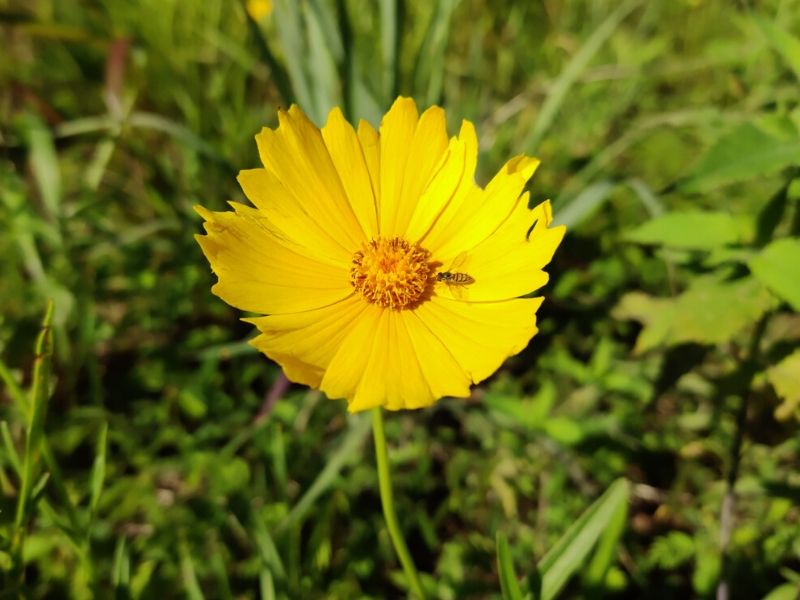
Plant enthusiasts recognize tickseed (Coreopsis verticillata) or also known as Creme Brulee or Coreopsis for their vibrant flowers in golden yellow (some varieties flaunt a dark brown center), purple, pink, orange, or red. They are named as such because their seeds bear a resemblance to ticks.
Like with most perennials, Tickseeds have several cultivars, and one of which, the Coreopsis leavenworthii, has been named as Florida’s state flower (17).
Tickseeds are generally short-lived and require full sun and well-drained soil to thrive. However, these yellow flowers can tolerate partial shade, especially in hot climates, but will not grow and bloom as much. Flowering occurs in early summer to fall, but deadheading will help keep tickseeds bloom throughout the summer.
Sea Holly
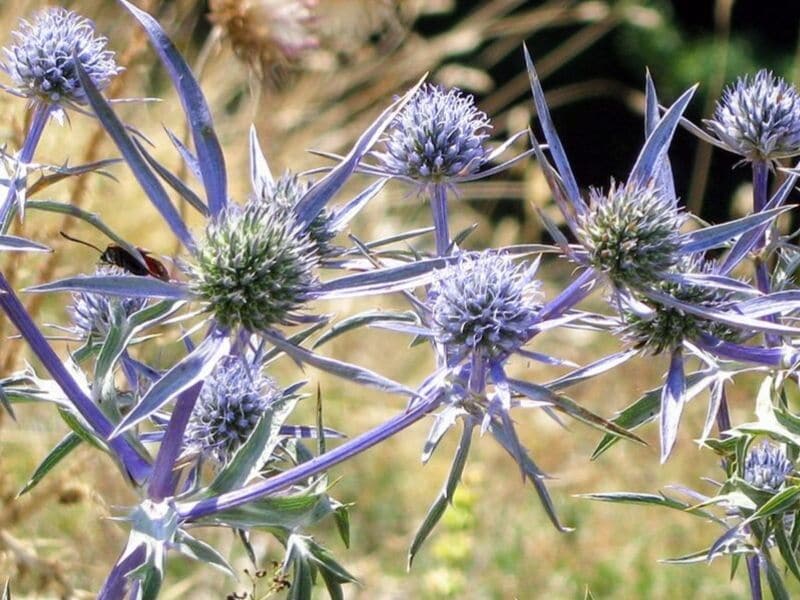
Sea Holly or Eryngium is an ornamental distinguished for its spiny leaves and metallic-like flowers that have whorls of prickly bracts or modified leaves at the base.
Sea Holly flowers vary in color, with the likes of green, blue, blue-purple, silver, and white, depending on the variety. The same goes for the leaves. Some types possess thin and long foliage, while others have deeply lobed leaves or rounded.
A symbol of strength, attraction, and independence, Sea Holly is one of the easiest perennials to grow and maintain. It requires minimal care as it develops best even in poor and dry soil conditions. Each plant grows about 1 to 3 ft high once fully established and blooms during summer to fall.
There are no reports on the toxic effects of Sea Holly. This attractive perennial is non-toxic and safe.
Forget-Me-Not
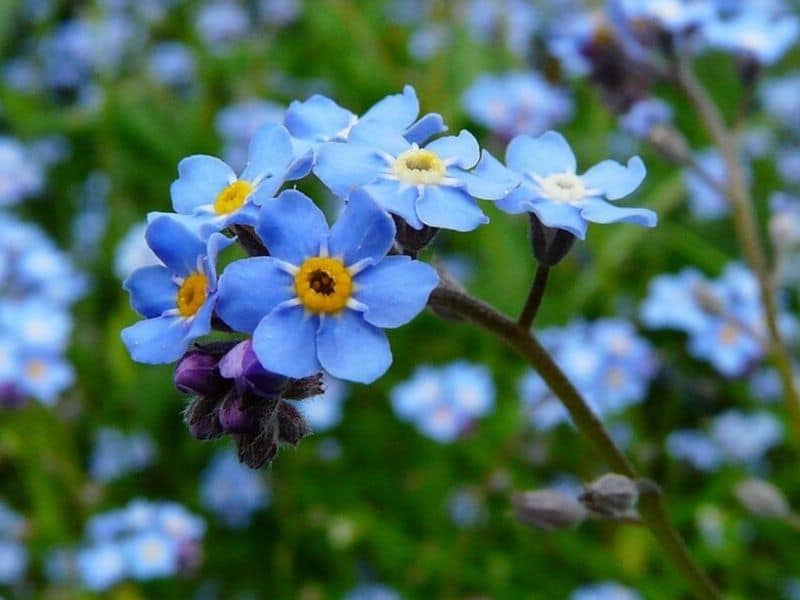
Forget-Me-Nots flaunt small petals that look like mouse’s ears, which give an accurate description to this perennial’s genus Myosotis’ Ancient Greek name meaning.
The most common types of Forget-Me-Nots are the Myosotis sylvatica (Woodland Forget-Me-Not) and the Myosotis scorpioides (True Forget-Me-Not). They flaunt five-petaled small blue flowers with contrasting yellow centers. They typically grow 0.5 ft to 1 ft height upon maturity and blossoms in spring to summer (18).
Most Forget-Me-Not plants are native to New Zealand. While the most common types come in blue color, others have pink and white flowers. This perennial, in general, flourish either in partial or full sun and well-drained soil.
Gardeners with small kids and pets should not fret about planting these shade-loving ornamentals as they are non-toxic and far from being harmful.
Bleeding Heart

Bleeding Heart or Lamprocapnos spectabilis is a flowering plant native to eastern Asia that sure knows how to turn heads with its distinct heart-shaped, pink blooms that emerge from 10 to 15 inches tall arched stems.
This herbaceous perennial forms from fleshy roots and could grow about 1.5 to 4 ft tall once fully established. Unlike most flowering perennials, Bleeding Heart requires a little maintenance. It needs consistently moist and fertile soil and prefers partial shade (19).
Some of the most renowned Bleeding Heart cultivars include Alba (white flowers), Gold Heart (bright golden-green foliage), and Fringed Bleeding Heart (smaller flowers).
Do not be deceived by this plant’s beauty, in any case. Despite its attractive facade, it can bring danger to pets if consumed in high quantities since it contains isoquinoline alkaloids.
Garden Phlox
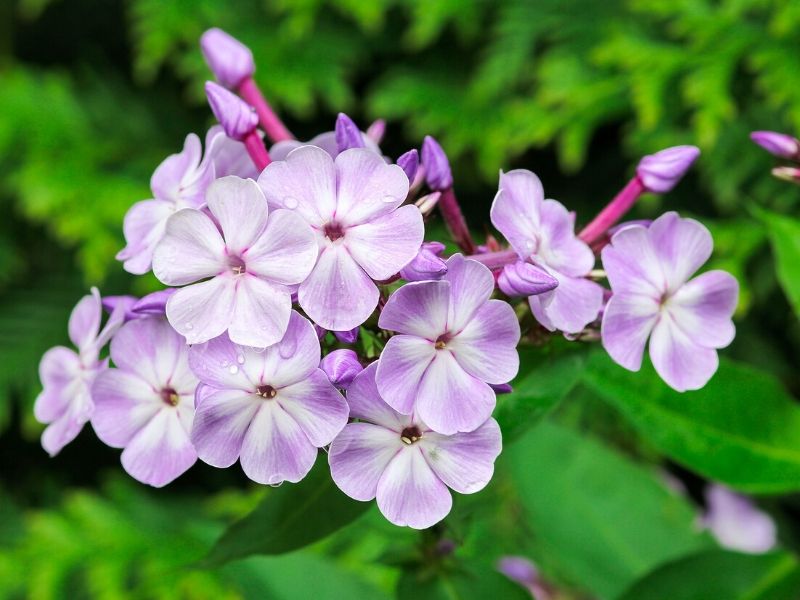
Garden Phlox, Phlox paniculata, adds vivid and captivating colors in any backyard from summer to fall. The long-blooming Garden Phlox form dense clusters or panicles of exquisite five-petaled flowers, typically in pink, red, lavender, purple, white, rose, orange, or bi-colors.
Native to most parts of the eastern and central United States, these flowering perennials are currently available in hundreds of cultivars.
Generally, Garden Phlox tolerates light shade, but it grows best under full sunlight as shading decreases flowering quantity and quality (20).
Also, Garden Phlox is an excellent choice if you have a pet who likes to nibble on plants. This flowering perennial is pet-safe as it is not toxic to animals and humans.
Bellflowers

Bellflowers or Campanulas, which are distinguished for their bell-shaped flowers, are one of the most well-known and easy-to-grow genera of perennials.
Although the entirety of the genus offers a variety of flower shapes other than the bell-shaped ones and flower colors, Bellflowers gained popularity because of their distinctive inflorescence in hues of light blue, lavender, pink, or white.
The majority of Bellflowers flourish best when grown under full sun and well-drained soil, though some species, including Milky Bellflowers (Campanula lactiflora), Giant Bellflowers (Campanula latifolia), and Korean Bellflower (Campanula takesimana), can tolerate part shade and prefer moist soils (21).
All parts of Bellflowers have no toxic effect on animals and humans. They are one of the many safe ornamental plants that one could include in a pet-friendly garden.
Canna Lily
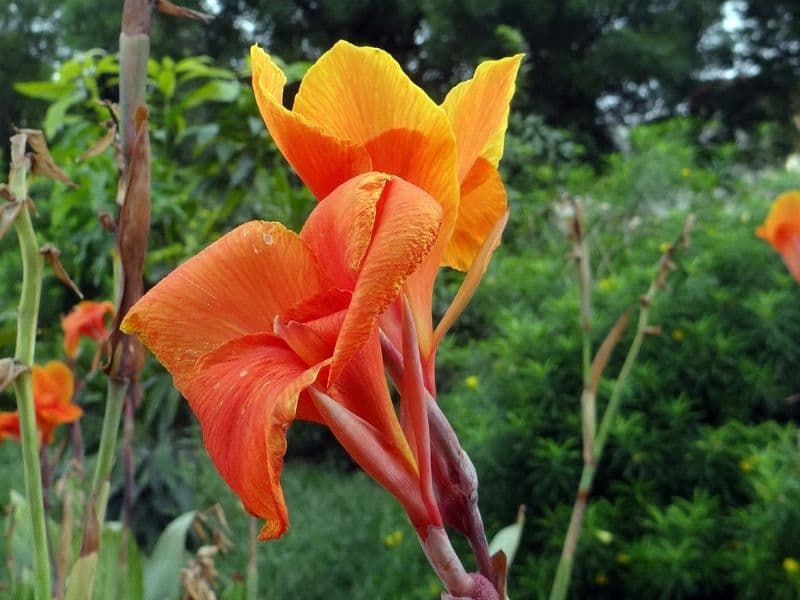
If you are looking to make a focal point in your landscape, Canna Lilies should make it into your list of options. Canna Lilies, or Cannas, are tropical and subtropical ornamentals characterized by prominent, paddle-shaped, striped foliage and vibrant blooms.
Cannas are low maintenance and easy to grow. These perennials grow either from seed or rhizomes and reach up to 2 to 6 feet tall, depending on the variety.
Deadheading can be done to encourage continuous flowering throughout the season. Flower colors range from red with yellow borders to scarlet and orange.
Another pet-friendly ornamental, Canna Lillies are a favorite of many plant enthusiasts not only for their reliability. These flowering perennials are safe to plant around pets and small children as they are harmless and non-toxic.
Red Hot Poker
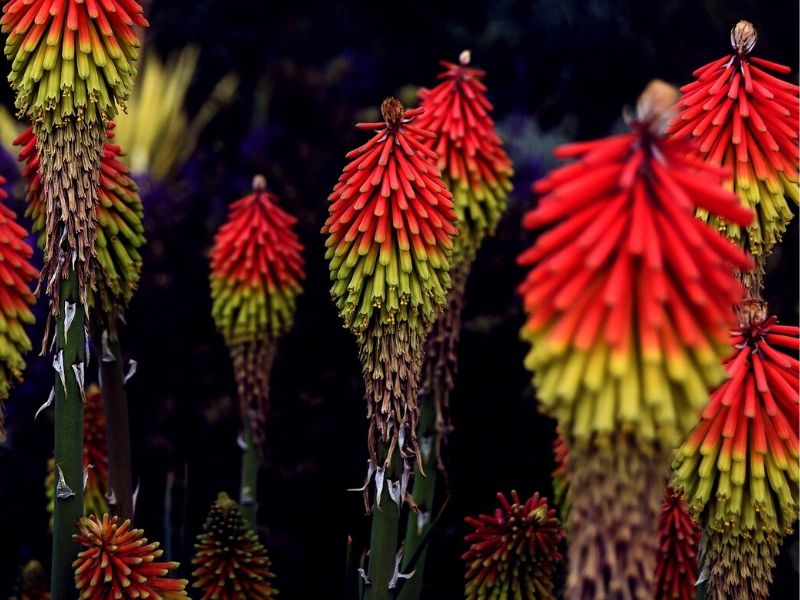
Another striking flowering perennial that’s hard not to get noticed is the Red Hot Poker or Torch Lilies or Kniphofia uvaria.
Part of the Liliaceae family, this plant boasts long-lasting bright orange, red, yellow, or cream bottlebrush-shaped inflorescence that resembles a burning torch. These flower spikes initially have muted colors, but soon become vivid as they grow.
Full-grown Red Hot Pokers can be as tall as 3 ft to 4 ft, with linear, v-shaped leaves that are about 30 inches long (22). As drought and heat tolerant perennials, these plants love full sun and sandy soil. Blooming commence from last spring to early fall.
Hollyhock
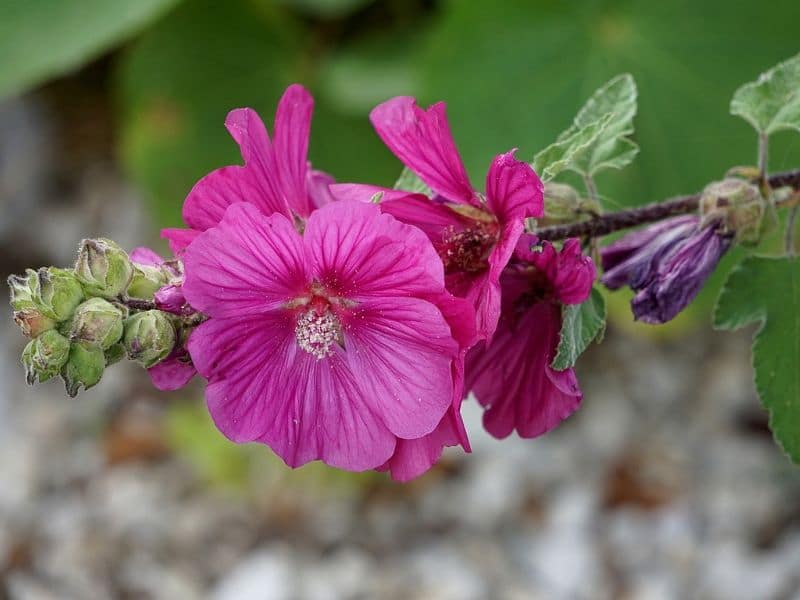
Hollyhock or Alcea rosea is a short-lived flowering perennial from the family of Hibiscus. It usually grows up to 6 ft tall with a single unbranched flowering stalk.
Often regarded as an old-fashioned garden plant, Hollyhocks have made it into the list of the most popular blooms. As soon as flowering commences, Hollyhock blooms remain open for 3 to 4 days during late spring and early summer.
Most varieties produce single flowers in varying hues, such as red, white, yellow, and rose, while other types form double flowers that look like powder puffs (23).
Maximize the beautiful blooms of Hollyhocks by planting them in full sun and well-drained, moist, and fertile soil. They tolerate partial shade, though flowers may not be as vibrant.
Hollyhocks are not harmful when ingested. However, these plants can induce mild skin irritation if touched.
Lavender

The Lamiaceae or mint family holds a genus of flowering plants that are grown for their beautiful flowers and fragrance called Lavandula, or commonly known as Lavender.
One of the most versatile ornamentals, lavenders are widely cultivated for several uses, including landscaping, food, oil, cosmetics, and herbal medicine. Lavender flowers can be used in cooking, while the leaves produce essential oils (24).
These plants can tolerate drought, but they bloom best if grown in well-drained soil and full sun. Common problems for Lavenders include fungal diseases in humid climates and root rot due to excess water.
Generally, Lavenders can be considered toxic to pets like dogs and cats. They may cause nausea, vomiting, and inappetence.
Russian Sage

The Russian Sage, a woody perennial from the mint family, is ideal for hot and dry climates. This drought-tolerant flowering plant requires minimal maintenance and performs best if grown in full sun and well-drained soil.
These lupine like flowers produces small purple-blue flowers formed in whorls along stems and elongated gray-green leaves.
Russian Sage has seven known species, but the most popular is the Perovskia atriplicifolia. It grows about 3 to 4 ft in height and blooms throughout the summer season.
Russian Sage plants are inedible. Though the leaves are poisonous and may cause skin irritation upon contact, Russian Sage is non-toxic in general.
Shasta Daisies
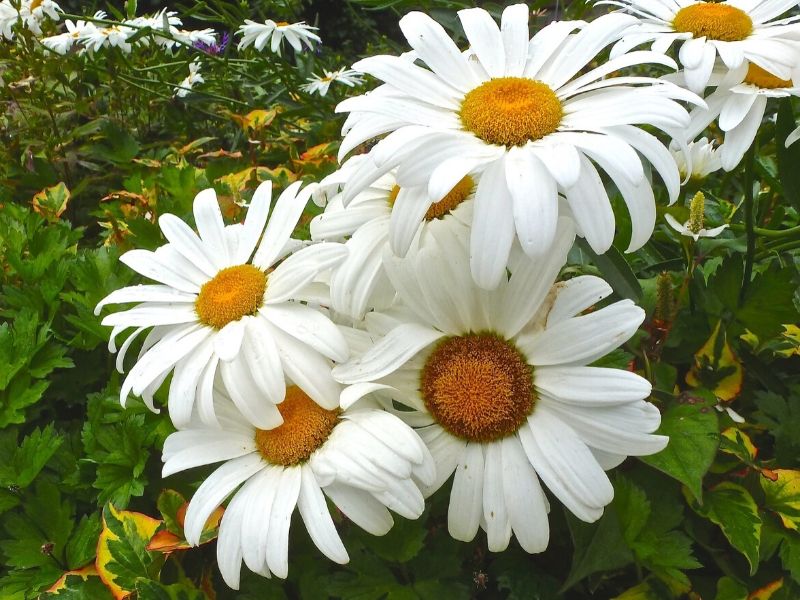
This gorgeous flowering plant grows about 1ft to 3 ft in height and presents mesmerizing summer blooms, typically in white petals with a bright yellow center.
Also identified as Leucanthemum x superbum, Shasta Daisies bloom in early spring and summer. These herbaceous perennials thrive best if planted in partial shade or full sun and fertile soil with good drainage. Deadheading will promote more copious blooms.
Like Mums, Shasta Daisies can be poisonous to pets. These plants can cause dermatitis, diarrhea, vomiting, and hyper-salivation.
Speedwell
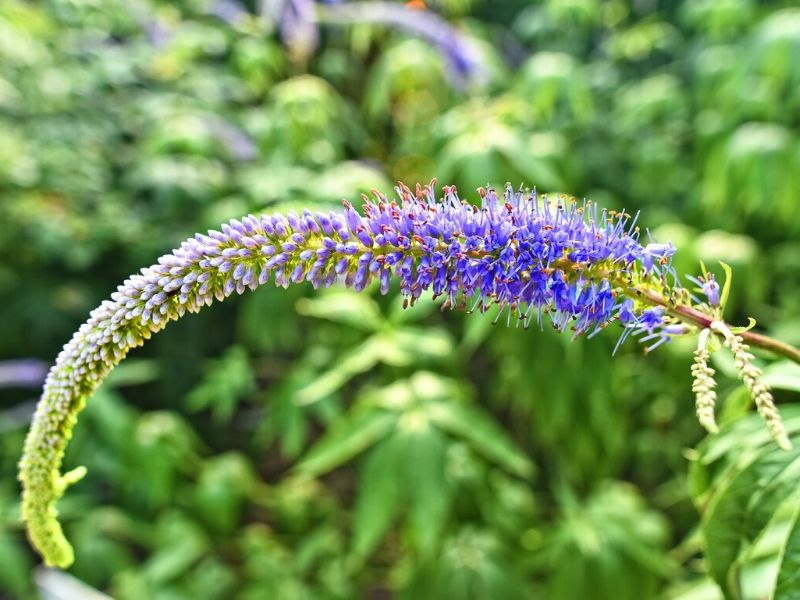
Speedwell, Veronica umbrosa, is a tough ornamental acknowledged by other names such as Veronica and Georgia Blue. It grows well even in harsh soil and water conditions and requires minimal care and maintenance once fully established.
Most Speedwells are native to Europe. They flaunt loose clusters of blooms that last throughout the summer. Flower hues vary depending on the variety, which can be deep purple, deep blue, white, deep violet-blue, sapphire blue, magenta pink, and rose pink.
Catmint
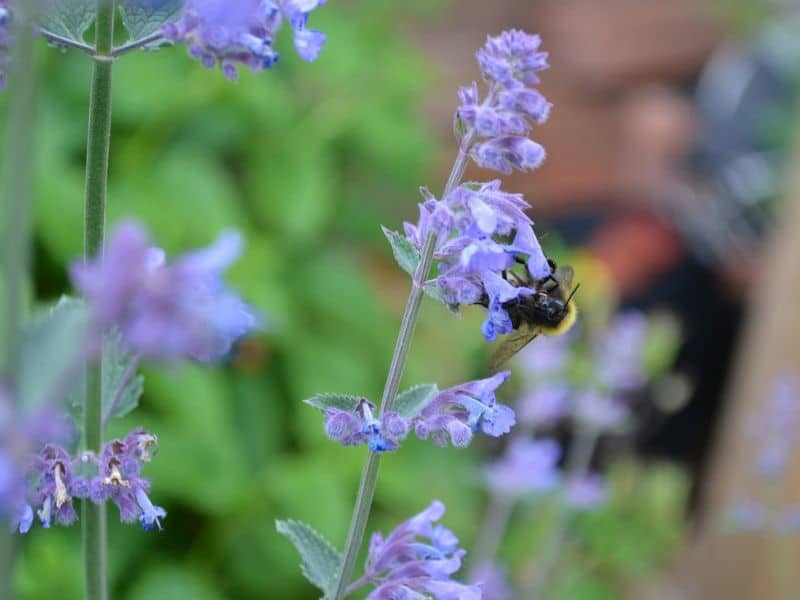
An aromatic herb that can add a splash of colors in your garden comes in the form of Catmint or Nepeta. These long-lived perennials are many gardeners’ favorite addition in their collection of ornamentals for various reasons.
Not only are these low-growing plants easy to grow, but they are incredibly versatile as well and can handle different soil conditions, including hard clay, as long as you provide them with enough sunlight.
Catmints are fast-growing and reach up to 3 ft high and 3 ft wide upon maturity. They present attractive gray-green foliage and often blue or lavender flowers in a spike-like form that blossom in early summer to early fall (25).
Penstemon
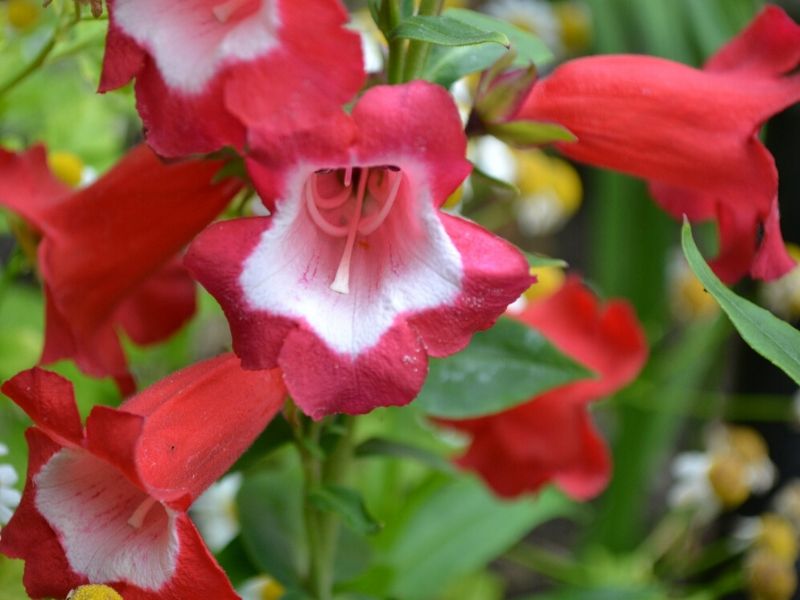
Also known as Beardtongue, Palmer’s Penstemon or Penstemon is a perennial forb or sub-shrub valued not just for its gorgeous flowers but also for erosion control (26).
This long-flowering plant features opposite, fleshy leaves with toothed margins and several clusters of rounded flowers. Each flower has five-lobed calyx (sepals) and a cylindrical corolla (petals). Flower hues range from pink to white, purple, red, and yellow (27).
A native of the southwestern part of the United States, Penstemons are drought-tolerant and prefer full sun or part shade, low moisture, and well-drained, sandy soil. These red flowers grow about 3.5 ft to 7 ft in height and 2 ft in width once fully established. Flowering commences from late summer to spring.
Pincushion Flower

Pincushion Flower or Scabiosa is one of the easiest to grow garden plant that produces exceptional flowers. Some Scabiosas, like the Scabiosa atropurpurea, are cultivated as an annual, while others, like the Scabiosa caucasica, are considered perennials.
Typically, pincushion flowers come in blue, white, or pink hues with a cushion-like center and pin-like stamens (hence the name pincushion). The fascinating inflorescence appears from late spring or early summer until the first frost.
Make the best out of Pincushion Flowers by planting them in full sun and well-drained, rich soil. They require minimal care once fully established, but make sure not to expose them in extremely wet or cold conditions (28).
Lamb’s Ear
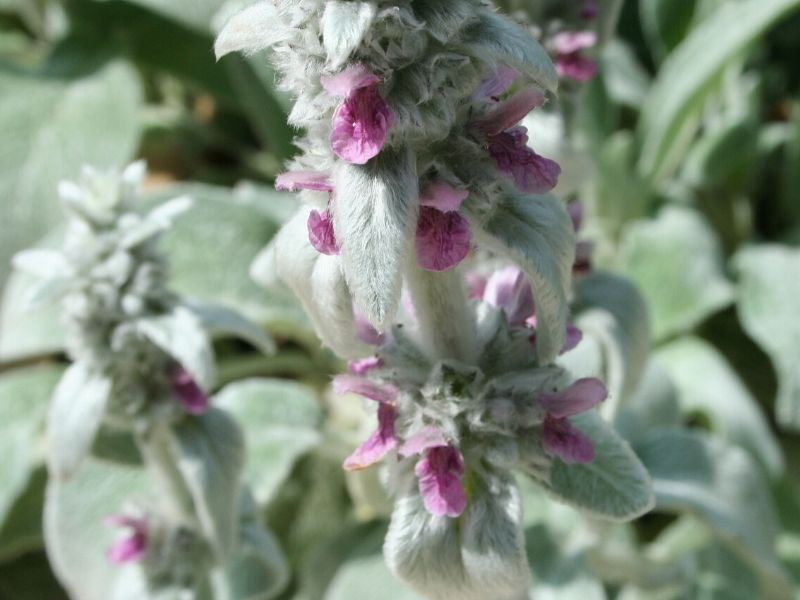
Lamb’s Ear or Stachys byzantina is a robust herbaceous perennial that belongs in the Mint family. Often highly-valued as an excellent bedding plant, it produces soft, velvety, and sliver-like evergreen foliage and elongated spikes of pink-purple flowers that show their beauty during the summer.
Lamb’s Ears endure poor soil and drought-like conditions, but it thrives best in full sun and well-drained soil.
Other common names of this plant include Lamb’s Tail, Lamb’s Tongue, Woolly Woundwort, and Woolly Betony (29).
Balloon Flower
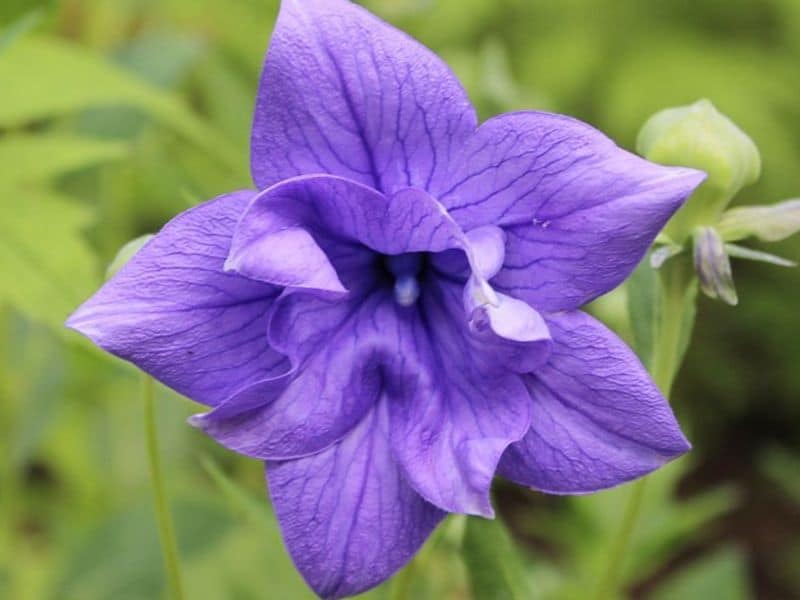
This long-lived perennial flowering plant is another top-favorite among gardeners worldwide. Known for its attractive and poppable petals, Balloon Flower or Platycodon grandiflorus blooms abundantly in the summer long, especially if planted in full sun and well-drained soil.
Balloon Flowers fall under the Campanula or Bellflower family. These spiky flowers display a star-shaped, violet-blue, white, or pink flowers and usually grow 1 ft to 2 ft tall and 1 ft wide when fully matured.
These star shaped flowers have poisonous roots and slightly toxic leaves, particularly the older and basal leaves. A native to China, Korea, Japan, and Russia, Balloon Flowers are also known as Chinese Bellflower and Japanese Bellflower.
Poppies

Poppies are flowering herbaceous ornamental plants that can either be annual or deep-rooted perennials.
Perennial poppies like Oriental Poppy (Papaver orientale), Iceland Poppy (Papaver nudaucaule), and Alpine Poppy (Papaver alpinum) are short-lived and often starts flowering in early to mid-summer. Poppies, in general, form large and toothed foliage and colorful flowers in white, pink, red, or purple depending on the variety.
These plants bloom best in full sun or part shade and fertile, well-drained soil. They are drought-tolerant once fully established Mature plants reach about 2 to 4 ft high and 2 ft wide.
Poppies are highly poisonous. Most plant parts contain alkaloids that can induce convulsions, asphyxiations, and in some cases, death (30).
Roses
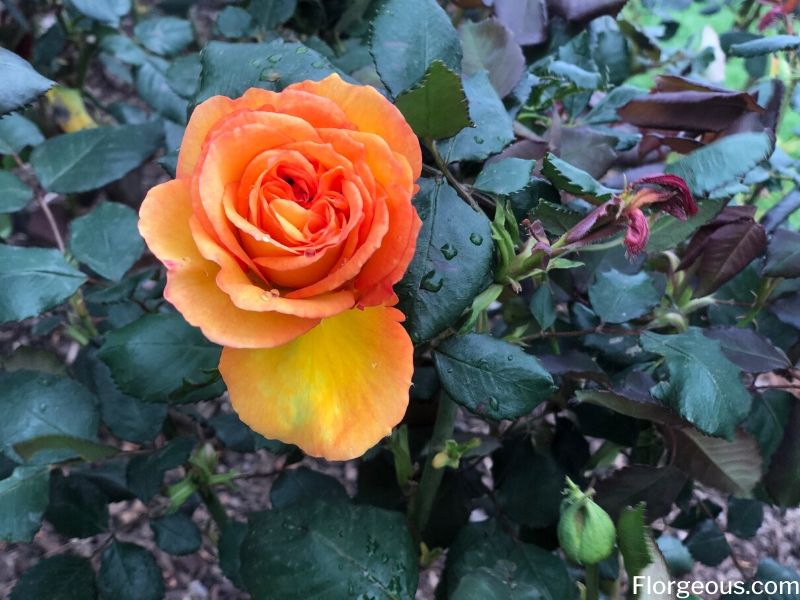
Roses are woody flowering perennial plants from the Rosaceae family. Most Rose species have five-petal flowers with five sepals underneath, while others like the Silky Rose (Rosa sericea) have four petals and four sepals per flower.
Extensive color options are available, which range from white to pink, yellow, red, orange, black, blue, green, maroon, and more. These flowering shrubs have alternate leaves that are long and pinnate.
Though famed as valuable cut flowers and garden plants, roses also produce oils used for perfumes. Did you know that roses are the June Birth Flower?
Roses perform best when planted in a sunny environment with fertile, well-drained, loam soil. They require at least 6 hours of direct sun during the day, as exposing them in the shade may increase the occurrence of pests like mildew and thrips.
Dianthus
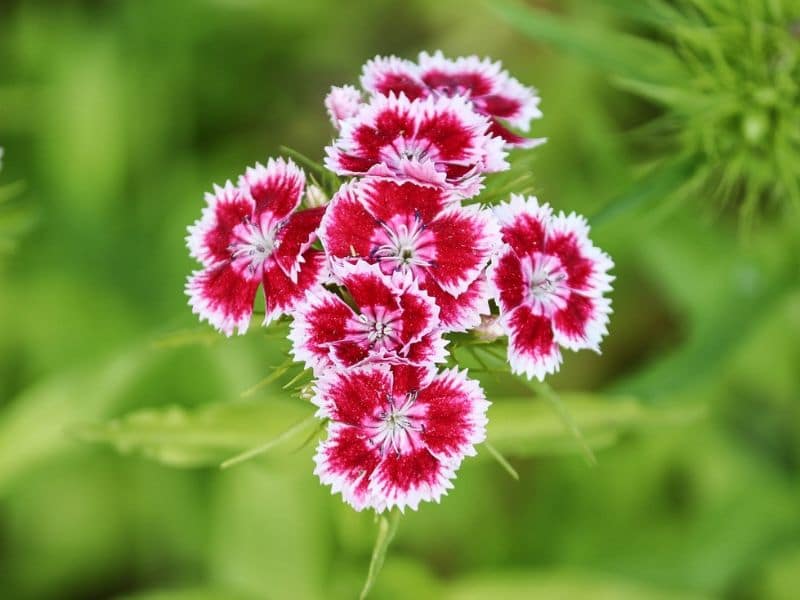
Otherwise called Pinks, Dianthus is a group of flowering plants native to Asia and Europe. With hundreds of species and cultivars available, Dianthus can be annual, biennial, or perennial.
Most perennial Dianthus grow up to about 10 inches to 20 inches tall and produce fragrant five-petal flowers in an assortment of shapes and colors. Blooms appear in pink, red, rose, yellow, and purple in the spring and late summer to first frost, while the leaves are often grayish-green or blue-green (31).
These plants are ideal for border plantings, containers, or rock gardens to add a splash of bright color in a landscape. Pinks perform in well-drained, neutral to slightly alkaline soil and full sun exposure, though they tolerate light shade as well.
Dianthus plants have poisonous capabilities. These perennial flowers can cause low toxicity if ingested and mild skin irritation upon contact (32).
See more: Annuals vs. Perennials
References
Reference list
(1) Passel.unl.edu. (2019). Plant and Soil Sciences eLibrary. [online] Available at: https://passel.unl.edu/pages/informationmodule.php?idinformationmodule=1120069862&topicorder=2&maxto=6&minto=1
(2) Nrcs.usda.gov. (2019). [online] Available at: https://www.nrcs.usda.gov/Internet/FSE_PLANTMATERIALS/publications/etpmcpg13467.pdf.
(3) Norcini, J., Aldrich, J., Thetford, M., Klock-Moore, K., Bell, M. and Harbaugh, B. (2001). Growth, Flowering, and Survival of Black-eyed Susan from Different Regional Seed Sources. HortTechnology, 11(1), pp.26-30.
(4) Karsch-Völk, M., Barrett, B. and Linde, K. (2015). Echinacea for Preventing and Treating the Common Cold. JAMA, 313(6), p.618. – link
(5) Perry, L. (2019). Daffodils for All Gardens. [online] Pss.uvm.edu. Available at: https://pss.uvm.edu/ppp/articles/daffodils.html
(6) Dana, M. and Lerner, R. (2001). The Peony: State Flower of Indiana. [online] Available at: https://ag.purdue.edu/hla/pubs/HO/HO-76.pdf
(7) Rodriguez-Enriquez, M. and Grant-Downton, R. (2012). A new day dawning: Hemerocallis (daylily) as a future model organism. AoB Plants, 5(0), pp.pls055-pls055. – link
(8) U.S. Food and Drug Administration. (2019). Lovely Lilies and Curious Cats: A Dangerous Combination. [online] Available at: https://www.fda.gov/animal-veterinary/animal-health-literacy/lovely-lilies-and-curious-cats-dangerous-combination.
(9) Davidson, Campbell. (2007). Monarda, Bee Balm Monarda didyma. 10.1007/978-1-4020-4428-1-28.
(10) Mavrodiev, E., Martínez-Azorín, M., Dranishnikov, P. and Crespo, M. (2014). At Least 23 Genera Instead of One: The Case of Iris L. s.l. (Iridaceae). PLoS ONE, 9(8), p.e106459. – link
(11) Wall, Dora (1970). The Iris Legend. American Iris Society. Vol. 196. pp. 124.
(12) Ag.ndsu.edu. (2019). Sedums are Radiant and Reliable — Lawns, Gardens & Trees. [online] Available at: link
(13) Hardy-plant.org.uk. (2019). [online] Available at: https://www.hardy-plant.org.uk/docs/publications/journal/37b/heuc.pdf
(14) Applequist, W. and Moerman, D. (2011). Yarrow (Achillea millefolium L.): A Neglected Panacea? A Review of Ethnobotany, Bioactivity, and Biomedical Research1. [online] https://www.researchgate.net/. Available at: link
(15) Sites.evergreen.edu. (2019). Yarrow: The Healing Herb of Achilles | . [online] Available at: https://sites.evergreen.edu/plantchemeco/yarrow-the-healing-herb-of-achilles
(16) Perry, L. (2019). Perennial Plant Feature: Fall Asters. [online] Pss.uvm.edu. Available at: https://pss.uvm.edu/ppp/articles/asterspp.html
(17) Howe, E. (2019). FPS143/FP143: Coreopsis spp. Tickseed, Coreopsis. [online] Edis.ifas.ufl.edu. Available at: http://edis.ifas.ufl.edu/fp143.
(18) Plants.ces.ncsu.edu. (2019). Myosotis sylvatica (Forget-me-not) | North Carolina Extension Gardener Plant Toolbox. [online] Available at: https://plants.ces.ncsu.edu/plants/myosotis-sylvatica/
(19) Master Gardener Program. (2011). Bleeding Heart, Dicentra spectabili.
(20) Extension.umn.edu. (2019). Tall garden phlox. [online] Available at: https://extension.umn.edu/flowers/tall-garden-phlox.
(21) Perry, L. (2019). Bellflowers (Campanula). [online] Pss.uvm.edu. Available at: https://pss.uvm.edu/ppp/articles/bellflowers.html
(22) Klingaman, G. (2008). Red Hot Poker. [online] University of Arkansas System Extension Service. Available at: https://www.uaex.edu/yard-garden/resource-library/plant-week/redhot-poker-9-19-08.aspx.
(23) Klingaman, G. (2002). [online] University of Arkansas System Extension Service. Available at: https://www.uaex.edu/yard-garden/resource-library/plant-week/hollyhock.aspx.
(24) Perry, L. (2019). Growing and Using Lavender. [online] Pss.uvm.edu. Available at: https://pss.uvm.edu/ppp/articles/lavender.html
(25) Schalau, J. (2019). Backyard Gardener – Catnip and Catmint – September 20, 2017. [online] Cals.arizona.edu. Available at: https://cals.arizona.edu/yavapai/anr/hort/byg/archive/catnipandcatmint.html
(26) Plants.usda.gov. (2019). [online] Available at: link.
(27) California Native Plant Society – Calscape.org. (2019). Palmer’s Penstemon, Penstemon palmeri.
(28) Daughtry, M. (2018). Pincushion Flower. [online] lee.ces.ncsu.edu. Available at: https://lee.ces.ncsu.edu/pincushion-flower/
(29) Arnold, M. (2019). Aggie-horticulture.tamu.edu. [online] Available at: https://aggie-horticulture.tamu.edu/syllabi/608/Lists/second%20ed/Stachysbyzantina.pdf
(30) Dpipwe.tas.gov.au. (2019). Dangers of poppies . [online] Available at: https://dpipwe.tas.gov.au/agriculture/plant-industries/tasmanian-poppy-industry/dangers-of-poppies
(31) Wolf, M. (2015). Darling Dianthus – Extension. extension.colostate.edu.[online] Available at: https://extension.colostate.edu/topic-areas/yard-garden/darling-dianthus/
(32) Plants.ces.ncsu.edu. (2019). Dianthus (Carnation, Clove Pinks, Pinks, Rainbow Pinks) | North Carolina Extension Gardener Plant Toolbox. [online] Available at: https://plants.ces.ncsu.edu/plants/dianthus
Close

